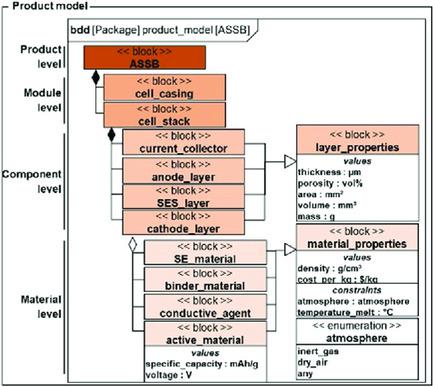当前位置:
X-MOL 学术
›
Energy Technol.
›
论文详情
Our official English website, www.x-mol.net, welcomes your
feedback! (Note: you will need to create a separate account there.)
Scalable Processing Routes for the Production of All‐Solid‐State Batteries—Modeling Interdependencies of Product and Process
Energy Technology ( IF 3.6 ) Pub Date : 2020-10-29 , DOI: 10.1002/ente.202000665 Célestine Singer 1 , Joscha Schnell 1 , Gunther Reinhart 1
Energy Technology ( IF 3.6 ) Pub Date : 2020-10-29 , DOI: 10.1002/ente.202000665 Célestine Singer 1 , Joscha Schnell 1 , Gunther Reinhart 1
Affiliation

|
The all‐solid‐state battery (ASSB) based on a solid ionic conductor is a significant future concept for energy storage. In respect of the growing global demand for batteries, a systematic study on processing thin‐layer and large‐area ASSBs is addressed herein. As ASSB cells are mainly produced on a laboratory scale, an introduction to industrial production is needed. Therefore, the formation, ranking, and selection of technology chains are presented concerning the strategic orientation of cell manufacturing companies. A system model consisting of five sub‐models is created, which connects technologies with production‐relevant parameters. The results are used for a tool that automatically generates and evaluates technology chains in dependence of the ASSB cell design. Starting from the layer fabrication technologies further up‐ and downstream processes are defined. For sulfidic solid electrolytes, e.g., a ball milling followed by the aerosol deposition method, hot pressing, and laser cutting are favorable in terms of high‐quality layers and low production volume, whereas planetary mixing, tape casting, calendering, and die cutting are the choice for a high‐throughput production. Based on these findings, processing routes for every cell design and solid electrolyte material can be generated concerning company‐specific criteria, thus enabling the industrial application.
中文翻译:

用于生产全固态电池的可扩展加工路线-建模产品和工艺的相互依赖性
基于固态离子导体的全固态电池(ASSB)是未来储能的重要概念。考虑到全球对电池不断增长的需求,本文针对处理薄层和大面积ASSB进行了系统研究。由于ASSB电池主要在实验室规模生产,因此需要对工业生产进行介绍。因此,提出了有关电池制造公司战略定位的技术链的形成,排名和选择。创建了一个由五个子模型组成的系统模型,该模型将技术与生产相关的参数连接起来。结果将用于根据ASSB单元设计自动生成和评估技术链的工具。从层制造技术开始,定义了进一步的上下游工艺。对于硫化性固体电解质,例如球磨后再进行气溶胶沉积法,热压和激光切割,就高质量层和低产量而言是有利的,而行星式混合,流延,压延和模切则是有利的高通量生产的选择。基于这些发现,可以针对公司特定标准生成每种电池设计和固体电解质材料的加工路线,从而实现工业应用。胶带浇铸,压延和模切是高产量生产的选择。基于这些发现,可以针对公司特定标准生成每种电池设计和固体电解质材料的加工路线,从而实现工业应用。胶带浇铸,压延和模切是高产量生产的选择。基于这些发现,可以针对公司特定标准生成每种电池设计和固体电解质材料的加工路线,从而实现工业应用。
更新日期:2021-01-05
中文翻译:

用于生产全固态电池的可扩展加工路线-建模产品和工艺的相互依赖性
基于固态离子导体的全固态电池(ASSB)是未来储能的重要概念。考虑到全球对电池不断增长的需求,本文针对处理薄层和大面积ASSB进行了系统研究。由于ASSB电池主要在实验室规模生产,因此需要对工业生产进行介绍。因此,提出了有关电池制造公司战略定位的技术链的形成,排名和选择。创建了一个由五个子模型组成的系统模型,该模型将技术与生产相关的参数连接起来。结果将用于根据ASSB单元设计自动生成和评估技术链的工具。从层制造技术开始,定义了进一步的上下游工艺。对于硫化性固体电解质,例如球磨后再进行气溶胶沉积法,热压和激光切割,就高质量层和低产量而言是有利的,而行星式混合,流延,压延和模切则是有利的高通量生产的选择。基于这些发现,可以针对公司特定标准生成每种电池设计和固体电解质材料的加工路线,从而实现工业应用。胶带浇铸,压延和模切是高产量生产的选择。基于这些发现,可以针对公司特定标准生成每种电池设计和固体电解质材料的加工路线,从而实现工业应用。胶带浇铸,压延和模切是高产量生产的选择。基于这些发现,可以针对公司特定标准生成每种电池设计和固体电解质材料的加工路线,从而实现工业应用。









































 京公网安备 11010802027423号
京公网安备 11010802027423号